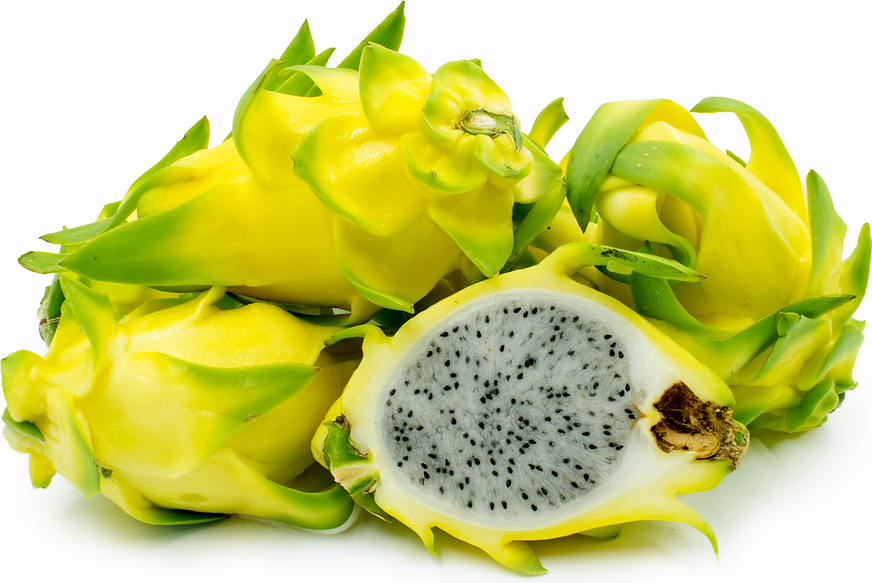


Israeli Yellow Dragon Fruit
Estimated Inventory, 6 lbs : 0
Description/Taste
Israeli Yellow pitaya are rounded fruits with an elongated shape and measure between 9 and 12 centimeters long and 7 to 10 centimeters wide. The Israeli Yellow pitaya does not have spines, instead, the thick skin is covered in the same soft bracts or scales as the red-skinned varieties. The fleshy protrusions growing outwards from the surface of the fruit are tipped with green. Within the fruit is a dense, translucent to white flesh speckled with numerous small, black edible seeds. Israeli Yellow Pitaya offer a juicy texture and sweet, tropical flavor, reminiscent of kiwi or pear.
Seasons/Availability
Israeli Yellow pitaya are available in the mid-summer and through the fall months.
Current Facts
Israeli Yellow pitaya, or Yellow Dragon fruit, was developed over a span of several decades by botanists at Ben-Gurion University of the Negev, in Beer-Sheva, Israel. The Israeli Yellow pitaya is a clone of the red fruited Hylocereus undatus and it has characteristics more akin to the red-skinned pitaya. To better distinguish it from its Central American yellow cousin, Selenicereus magalanthus, the fruit was named Golden pitaya, also known as Golden Dragon. It is also referred to as Yellow undatus, using its species name as another way to distinguish it from what some call the “real” yellow dragon fruit. Pitaya have become an important exotic food crop in Israel due to their low water needs, attractive flowers and nutraceutical benefits.
Nutritional Value
Israeli Yellow pitaya is a good source of magnesium, phosphorus and potassium. They also contain dietary fiber and protein and contain higher amounts of calcium than the red skinned varieties. The fruits provide a small amount of iron, vitamin A, niacin and vitamin C. Israeli Yellow pitaya are a good source of antioxidants and beneficial fatty acids. The edible seeds contain high amounts of omega-3 fatty acids that are beneficial to heart health.
Applications
Israeli Yellow pitaya are used most often raw. Cut the fruit only when ready to prepare. The flesh is generally scooped out of the halved fruit, leaving a shell that can serve as a natural bowl for the prepared flesh. The crisp, juicy flesh holds its shape well and can be diced, balled, or cut into cubes and then added to fruit salads, salsas or desserts. Its polka-dotted flesh offers unique visual appeal wherever used. Israeli Yellow pitaya pair well with other tropical fruits like mango or papaya. The flavor pairs well with fish like cod, tuna or mahi. Pureed pulp can be added to smoothies and cocktails or frozen and used to make sorbets and popsicles. To store, keep Israeli Yellow pitaya at room temperature until ready to use. Refrigerate for up to 2 hours prior to serving raw.
Ethnic/Cultural Info
Since the mid-1990’s Israel has been experimenting with different methods of pollinating and growing pitaya to explore its potential as an economically supportive exotic food crop in the country’s arid regions. The development of several new hybrid and cloned varieties has increased and expanded Israel’s export of the fruits and cuttings for propagation. Due to the nature of clones, the Yellow pitaya will not grow true from seed. Propagating the yellow fruit-bearing cactus clones must be done through cuttings.
Geography/History
Israeli Yellow pitaya was developed in Israel, a process that began in the 1994, and is now grown predominantly in Israel and on a small scale in Hawaii and Australia. This variety has recently been available through online tropical plant companies in Florida. Another variety of dragon fruit found in Nicaragua, Hylocereus costaricensis, will produce yellow-skinned clones and are smaller and more rounded than the fruits from Israel. Israeli Yellow pitaya cactus prefer the drier subtropical climates and are more tolerant of heat and sun exposure than the pink varieties but are less cold hardy. Israeli Yellow pitaya are exported primarily to Europe, though exports to the United States began in 2015 and have increased since that time.

Recipe Ideas
Recipes that include Israeli Yellow Dragon Fruit. One
Podcasts



